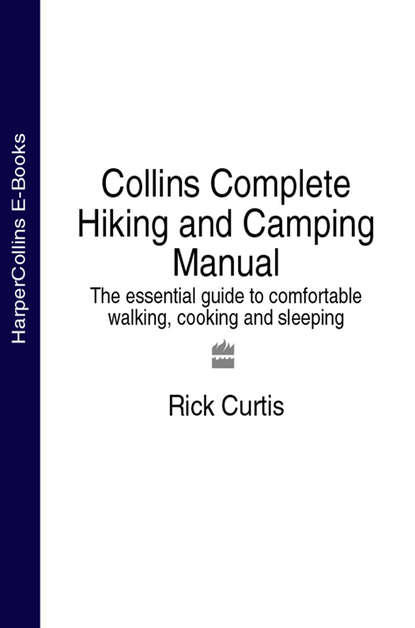По всем вопросам обращайтесь на: info@litportal.ru
(©) 2003-2024.
✖
Collins Complete Hiking and Camping Manual: The essential guide to comfortable walking, cooking and sleeping
Настройки чтения
Размер шрифта
Высота строк
Поля
Whether you’re going for a one-day hike on a local trail or a month-long expedition to a remote area, you need to thoroughly plan what equipment to bring. The equipment assessment for your trip should cover the following areas:
PERSONAL EQUIPMENT (#ulink_67e47bd3-640b-5c2e-94e7-61fe07ac313e)
Clothing Shirts, pants, boots, hats, and so on
Travel What is needed for travel—just your feet or a canoe, a bike, cross-country skis, etc.
Storage What you use to carry personal and group equipment—a backpack, bike panniers, waterproof bags for canoeing, etc.
Sleeping Sleeping bag, foam/inflatable pad
Miscellaneous Water bottles, toiletries, personal items
GROUP EQUIPMENT (#ulink_b3fb8946-5b84-5ddf-9e7e-d0d49c1c28b0)
Shelter Evaluate the type of shelter required for the size of the group and anticipated weather conditions—tarpaulin, tent, or shelters on the trail.
Cooking Stoves, pots and pans, utensils
Hygiene Items for water purification, handwashing, going to the bathroom
First aid See page (#litres_trial_promo) for a list of first-aid essentials
Repair Anticipate what might break and have the necessary replacement parts and tools.
When deciding what equipment to bring, review your planned route and answer the following questions:
How long is the trip?
How many people are going? How does that affect the amount of group equipment needed?
Are people providing their own personal equipment?
Who is providing group equipment?
What season is it? What are the typical maximum and minimum temperatures during the day? What is typical weather (foggy morning, afternoon thunderstorms, etc.)? What is atypical weather (can it snow in July)? (See “Weather and Nature (#litres_trial_promo).”)
What is the altitude? What effect will the altitude have on temperature? (See “Temperature Ranges (#litres_trial_promo),”.)
What are the trip activities? What equipment will be needed for different activities?
Where is the trip? Is it remote or accessible?
Is equipment resupply a possibility or will you have to carry everything?
Do you need any special equipment for Leave No Trace camping? (See Chapter 5 (#litres_trial_promo).)
How will you deal with equipment repair if things break? What equipment items are more likely to break? What equipment items, if broken, would create serious problems for the trip (e.g., stoves)?
THE ESSENTIALS (#ulink_45593384-c8a2-51e5-82cc-5fe1825af86b)
No matter where you are going, and whether you are out for a day or a month, there are some pieces of equipment that are considered essential for safe hiking travel. There are countless tales of hikers who have gotten into trouble, even on short day hikes, because they neglected these essentials.
Map
Compass (and knowledge of how to use it)
Extra food
Extra clothing (polypropylene, fleece, or other insulating clothing)
Water bottle (full, 1–2 quarts)
Flashlight/headlamp with extra batteries
Rain gear
Pocketknife
Matches/lighter (best to have at least two sources for lighting a fire)
Candle or firestarter to help light a fire
First-aid kit
Sunglasses and sunscreen
Other recommended items include:
Watch
Water purification system
Large rubbish bag, space blanket, tube tent, or small tarpaulin for emergency shelter
Foam or inflatable sleeping pad for ground insulation
CLOTHING (#ulink_c5ed645f-a82b-5f24-bce4-5d3a82bc4af2)
Knowing what to buy and wear is hard. There are so many different materials out there that do similar things, and everything has a fancy name that ends in something like -ex or -tec. As you are reading this, some industrial chemist in a lab somewhere is developing the next generation of smart fabrics while garment designers dream up innovative features. Clothing manufacturers crank out new lines so frequently that it isn’t possible to give you specific information on what’s available now, so here are some general guidelines to help you choose the best clothing for your trip.
REGULATING YOUR BODY TEMPERATURE (#ulink_d80b3f66-ecf7-5fb5-a5aa-4c63917b8389)
In order to plan the right clothing for a trip, you need to understand how your body reacts to the temperature and weather conditions you are likely to experience. Balancing the heat you are losing to the environment with the heat you generate from exercise and absorb from the environment is called thermoregulation. If you gain more heat than you lose, you experience a heat challenge. (See “Regulating Body Temperature (#litres_trial_promo),”.) If you lose more heat than you gain, you experience a cold challenge. The ability to regulate body temperature is critical for preventing hyperthermia and hypothermia. (See “Heat-Related Illnesses (#litres_trial_promo),” and “Hypothermia (#litres_trial_promo),”.)
One way to regulate body temperature is to wear the right clothing and layer your clothing properly. Clothing items should be versatile enough to meet the various seasonal and weather conditions you may encounter. Since each person’s body is different, experiment to determine your individual requirements.
How Your Body Loses Heat





